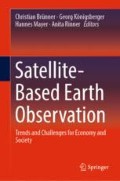Abstract
Since a decade, more than half of the world’s population lives in cities. This trend is expected to be continued in the upcoming decades, transforming our world into an urban planet. Especially urban regions in Asia and Africa will experience tremendous urban growth. Earth observation data provide unique possibilities in urban research for analyzing global urbanization processes due to a wide spectrum of satellites such as by the European Copernicus Programme providing large-area satellite data for monitoring urban change processes. Besides, also on a local scale, high resolution satellite imagery provides invaluable information for characterizing the physical urban environment, allowing for a qualitative mapping of the state of urban neighborhoods in the context of urban poverty. This paper provides an overview on global urbanization processes, the data toolbox of satellites for their analysis and selected applications to demonstrate the usefulness of satellite images for urban research.
Access this chapter
Tax calculation will be finalised at checkout
Purchases are for personal use only
References
Arimah BC (2010) The face of urban poverty. UNU-WIDER, United Nations University (Working paper No. 2010/30). https://www.wider.unu.edu/sites/default/files/wp2010-30.pdf. Accessed 16 Jan 2018
Casu F, Manunta M, Agram PS, Crippen RE (2017) Big remotely sensed data: tools, applications and experiences. Remote Sense Environ 202:1–2
Esch T, Taubenböck H, Roth A et al (2012) TanDEM-X mission—new perspectives for the inventory and monitoring of global settlement patterns. IEEE J Sel Top Appl 6(1):061702-1–061702-21
Giradet H (1996) Das Zeitalter der Städte. Neue Wege für eine nachhaltige Stadtentwicklung, Deukalion, Holm
Glaeser E (2011) Triumph of the city—how our greatest invention makes us richer, smarter, greener, healthier, and happier. Penguin Books, New York
Klotz M, Wurm M, Taubenböck H (2015) Der Werkzeugkasten der urbanen Fernerkundung—Daten und Produkte. In: Taubenböck H, Wurm M, Esch T, Dech S (eds) Globale Urbanisierung, Perspektive aus dem All. Springer Spektrum, Berlin Heidelberg, pp 29–38
Kuffer M, Pfeffer K, Sliuzas R et al (2017) Capturing the diversity of deprived areas with image-based features: the case of Mumbai. Remote Sens-Basel 9(4):384
NBS (National Bureau of Statistics of China) (2016): Total resident population. http://data.stats.gov.cn/english/easyquery.htm?cn=E0103. Accessed 12 Jan 2018
OECD (2010) Cities and climate change. OECD Publishing, Paris
Pesaresi M, Ehrlich D, Ferri S et al (2016) Operating procedure for the production of the global human settlement layer from landsat data of the epochs 1975, 1990, 2000, and 2014. http://publications.jrc.ec.europa.eu/repository/handle/JRC97705. Accessed 16 Jan 2018
Saunders D (2014) Arrival city—the final migration and our next world. Karl Blessing Verlag, München
Schneider A, Friedl MA, Potere D (2009) A new map of global urban extent from MODIS satellite data. Environ. Res. Lett. 4(4):044003
Siedentop S (2015) Ursachen, Ausprägungen und Wirkungen der globalen Urbanisierung—ein Überblick. In: Taubenböck H, Wurm M, Esch T, Dech S (eds) Globale Urbanisierung, Perspektive aus dem All. SpringerSpektrum, Berlin Heidelberg, pp 11–22
Taubenböck H, Wiesner M, Felbier A et al (2014) New dimensions of urban landscapes: the spatio-temporal evolution from a polynuclei area to a mega-region based on remote sensing data. Appl Geogr 47:137–153
Taubenböck H, Kraff N (2014) The physical face of slums: a structural comparison of slums in Mumbai, India, based on remotely sensed data. J Hous Built Environ 29(1):15–38
Taubenböck H (2015) Ohne Limit? Die Expansion von Megacities. In: Taubenböck H, Wurm M, Esch T, Dech S (eds) Globale Urbanisierung, Perspektive aus dem All. SpringerSpektrum, Berlin Heidelberg, pp 49–58
United Nations (2014): World urbanization prospects. https://esa.un.org/unpd/wup/Publications/Files/WUP2014-Highlights.pdf
United Nations General Assembly (2015): Resolution adopted by the General Assembly on 25 September 2015, 70/1. Transforming our world: the 2030 Agenda for Sustainable Development. http://www.un.org/ga/search/view_doc.asp?symbol=A/RES/70/1&Lang=E. Accessed 16 Jan 2018
Wei C, Taubenböck H, Blaschke T (2017) Measuring urban agglomeration using a city-scale dasymetric population map: a study in the Pearl River Delta, China. Habitat Int 59:32–43
World Bank (2014): Urban Development Overview. http://www.worldbank.org/en/topic/urbandevelopment/overview. Accessed 15 Jan 2018
Wurm M, Taubenböck H, Schardt M et al (2011) Object-based image information fusion using multisensor earth observation data over urban areas. Int J Image Data Fus 2(2):121–147
Wurm M, Taubenböck H, Weigand M, Schmitt A (2017) Slum mapping in polarimetric SAR data using spatial features. Remote Sense Environ 194:190–204
Wurm M, Taubenböck H (2018) Detecting social groups from space—assessment of remote sensing-based mapped morphological slums using income data. Remote Sens Lett 9(1):41–50
Acknowledgements
The author greatly acknowledges the provision of the WorldView-3 image of Shanghai by European Space Imaging.
Author information
Authors and Affiliations
Corresponding author
Editor information
Editors and Affiliations
Rights and permissions
Copyright information
© 2018 Springer International Publishing AG, part of Springer Nature
About this paper
Cite this paper
Wurm, M. (2018). Global Urbanization—Perspective from Space. In: Brünner, C., Königsberger, G., Mayer, H., Rinner, A. (eds) Satellite-Based Earth Observation . Springer, Cham. https://doi.org/10.1007/978-3-319-74805-4_11
Download citation
DOI: https://doi.org/10.1007/978-3-319-74805-4_11
Published:
Publisher Name: Springer, Cham
Print ISBN: 978-3-319-74804-7
Online ISBN: 978-3-319-74805-4
eBook Packages: Law and CriminologyLaw and Criminology (R0)

